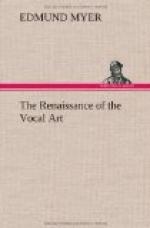All voices have two distinct color or character effects, the reed and the flute. These effects are the result of vowel forms, and of the predominating influence of high placing or of low resonance. When we desire brilliancy, the reed effect should predominate. When we desire dark color or more somber effects, the flute quality should prevail. In clear tone or timbre there is more reed effect than flute. In medium tone or color the effect of both is heard and felt. In the somber tone the flute predominates. To express joy or happiness we use the clear timbre, and the ring of high forward placing predominates. To express a deeper feeling, a more serious but not a sad tone, that which we call the emotional form, both the clear and the somber are heard in various proportions; the high placing and the low resonance are about equally balanced. To express sadness the somber color or low resonance predominates.
Apply these ideas on all the exercises given. Use sentences which contain thought or sentiment that will enable you to arouse a definite feeling. For example, to study the clear timbre, sing, “My heart is glad.” To express the emotional tone, the tone which is not sad but serious, sing, “My heart is thine.” To express a somber sound or sadness, sing, “My heart is sad.” To express a ringing, dramatic tone, sing, “Thy heart is false.” Thus we express four different effects on the one word, “heart.”
This subject of emotional expression through tone color and tone character is so great, so important, that it is impossible to do it justice in this little work. I have written more fully on this and kindred subjects in my other works, therefore I shall here touch but lightly upon the aesthetics of the vocal art.
It should be remembered that the prime object for which this book was written, was to place more clearly, if possible, before my readers, the importance and wonderful influence of the flexible, vitalized movements of our system.
These movements, we find, so directly influence the voice, the singer, and the results in every way, that we feel justified in again calling attention to them. Too much cannot be said of them, for the average student of the voice is inclined to neglect them. If they have been, to a certain extent, understood and mastered, then the study of this, the fourth principle of artistic singing, becomes a comparatively easy matter. With the student who does not understand them, emotional or self-expression is always a difficult matter, and with many an impossibility; which largely accounts for the great number of mechanical singers. At least twenty years’ hard work and study have been put upon these movements in order to reduce them to the simplest and most effective form. They are based upon common sense and Nature’s laws. Of course no one can or should expect to understand or fully appreciate them without more or less investigation.




